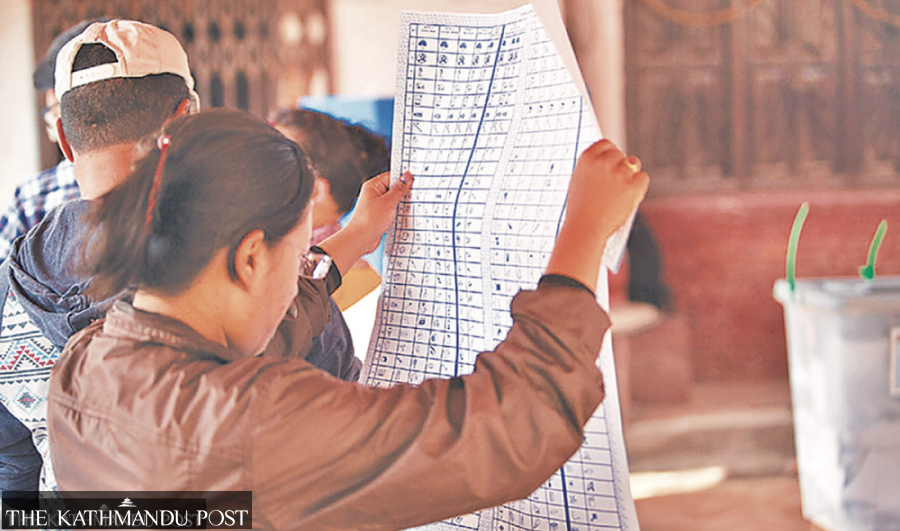National
Alliance politics may help parties but for first-time voters, it comes with confusion
During local level elections, an adult votes for seven candidates. Remembering all the symbols and cross-party candidates will be difficult, observers say.
Binod Ghimire
Aayush Regmi, 19, from Tulsipur Sub-metropolitan City Ward No. 16 is a first-time voter for the upcoming local elections. The 12th grader is excited that he is going to exercise his franchise, which will be important in deciding who is elected to govern his local level for the next five years.
A voter in a local federal unit can decide the fate of seven people, including the mayor and deputy mayor or chairperson and vice-chairperson.
“Franchise is one of the most important rights of a citizen in democracy. I am excited that my vote too will matter in selecting a new leadership,” he told the Post over the phone. “However, there is some confusion as the parties are forming alliances. I am not sure how many parties I will have to vote for.”
The five ruling parties have decided to contest the May 13 elections in an alliance while the CPN-UML too has partnered with Rastriya Prajatantra Party-Nepal and Nepal Pariwar Dal. For one willing to vote for the candidates from the ruling alliance, s/he has to know which party has fielded contenders in which position and remember their election symbol.
“The voting process is going to be confusing, especially for a first timer like me. The parties must be contesting elections individually,” said Regmi. “Alliance politics has imposed restrictions on the choices of candidates.”
The Election Commission has been printing ballot papers in full swing. The ballot papers from all the districts will have the election symbols of four parties in the ruling alliance and the UML and Loktantrik Samajbadi Party. The other parties will have their election symbols only on the ballot papers meant for the districts where they have a strong hold.
When the parties contest the elections forming an alliance, one party will have candidates in a couple of positions among the seven, though its election symbol will be on the ballot paper for all the positions. The voters will have to remember the candidate and his/her separate election symbols.
“By forming the electoral alliance, parties are imposing their candidates upon us. In principle, the more the parties, the more candidates to choose from. Why form so many parties when they have to contest elections forming a coalition with other parties,” questions Renish Rauniyar, 27, from Kathmandu Metropolitan City-13. “Forming an alliance is just a strategy to win the elections and remain in power. Youths like me must teach them a lesson through the right use of our votes this time.”
Records at the Election Commission show there are 17,733,723 voters for the upcoming local elections, up from 15,427,731 in the 2017 general elections. As many as 2,305,992 new voters like Regmi and Rauniyar, who could be decisive in next month’s local elections, have been registered in the last five years.
Political analysts say that forging alliances with the parties which have neither similar ideologies nor objectives doesn’t help strengthen parties or the democracy. “Alliance is generally forged between parties having similar ideologies and objectives but the only motive of this alliance is to win the elections,” Shree Krishna Aniruddha Gautam, a political analyst, told the Post. “This won’t do the parties good. Nor will this strengthen our democratic practice.”
All the parties in the five-party alliance carry different ideologies, where Rastriya Janamorcha wants revocation of federalism—one of the major achievements of the new constitution. It's a paradox that the Rastriya Janata Party led by Upendra Yadav, who is credited with ensuring federalism, is partnering with the Janamorcha.
In principle, the UML is a secular party and has contributed to Nepal’s declaration as a secular state. However, it has formed alliances with one party that carries the Hindu agenda and another party that promotes Christianity.
“A committed voter will find it difficult to stamp the electoral symbol of other parties while non-committed voters are sure to get confused,” said Gautam.
Even as the subordinate committees of ruling parties have decided to forge electoral alliances as per their party’s decisions, the local leaders themselves claim they will have a hard time convincing the voters.
Tehrathum district chair of CPN (Unified Socialist) Krishna Chongbang said their cadres and voters have been questioning them if the existence of the party and the election symbol could be in danger if they mark the election symbols of other parties. “We are having a difficult time convincing our voters and cadres but we tell them that the alliance was necessary to safeguard the constitution and democracy in the country,” Chongbang told the Post over telephone from Tehrathum.
The leaders say while they have no option but to follow what their party directs, they doubt if the motive of forming the alliance will be served.
Raju Gurung, chairperson of Siranchowk Rural Municipality in Gorkha who is also a local leader of the Nepali Congress, said the party’s supporters are not ready to vote for other parties. He said some voters have even warned against voting for the candidate from a rival party if the electoral alliance is forged.
“There is a chance that some of our votes could go to the opposition parties if our voters are not convinced about the alliance,” said Gurung. “The alliance could cause lots of problems, including a rise in invalid votes.”
Election observers say parties forming coalitions is increasing the complexities and confusions. “People get confused while voting even when the parties contest elections individually,” Pradip Pokharel, chairperson of the Election Observation Committee, Nepal, told the Post. “First-time voters will be more confused.”




 10.12°C Kathmandu
10.12°C Kathmandu
%20(1).jpg&w=200&height=120)














